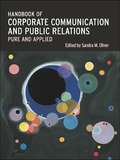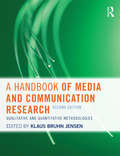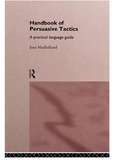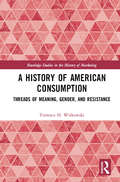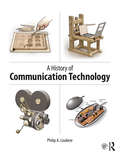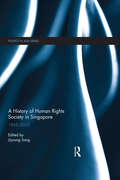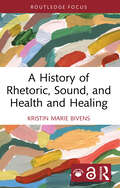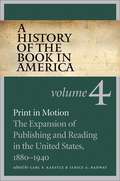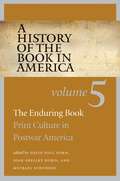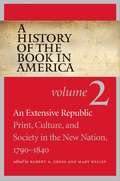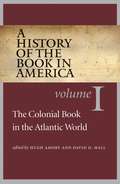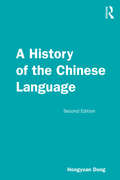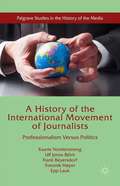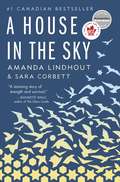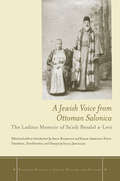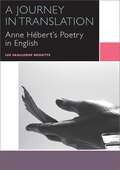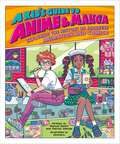- Table View
- List View
A Handbook of Corporate Communication and Public Relations: Pure And Applied
by Sandra M. OliverA bold addition to existing literature, this book provides an excellent overview of corporate communication. Taking an interdisciplinary approach, it offers readers the in-depth analysis required to truly understand corporate communication, corporate strategy and corporate affairs as well as the relevant public relations issues.With a refreshing ne
A Handbook of Journalism: Media in the Information Age
by V. Eshwar Anand K. JayanthiJournalism as a discipline is becoming increasingly important today. It has to contend with new challenges such as the explosion of social media, heightened commercial competition in the mainstream media and the emergence of the media as a powerful actor in public policy and governance. The confluence of these factors calls for fresh thinking about the teaching and practice of journalism. A Handbook of Journalism: Media in the Information Age not only helps readers to understand today’s media environment but also prepares them to face the existing challenges. Distinguished editors, experts, academics and journalists join to examine these challenges from various angles, including some of the major contemporary trends, issues and processes in governance, institutions, administration and development, among others. The book fairly and objectively discusses a critical discipline that is at the crossroads.
A Handbook of Media and Communication Research: Qualitative and Quantitative Methodologies
by Klaus Bruhn JensenA Handbook of Media and Communication Research presents qualitative as well as quantitative approaches to the study of media and communication, integrating perspectives from both the social sciences and the humanities. Taking methodology as a strategic level of analysis that joins practical concerns with theoretical issues, the Handbook offers a comprehensive and in-depth review of the field and a set of guidelines for how to think about, plan, and carry out media and communication studies in different social and cultural contexts. The second edition has been thoroughly updated with reference to the development of the internet, mobile, and other digital media. Each chapter addresses shifting configurations of established media organizations, media discourses, and media users in networked practices of communication. The introduction and one further chapter probe changing conceptions on mass and interpersonal, online and offline communication – in research as in everyday life. Three new chapters have been added to exemplify different forms of research employing multiple methods to study multiple media in multiple contexts. List of contributors: Klaus Bruhn Jensen, Barrie Gunter, Rasmus Helles, Annette Hill, Stig Hjarvard, Peter Larsen, Amanda Lotz, Graham Murdock, Horace Newcomb, Paddy Scannell, Lynn Schofield Clark, Kim Christian Schrøder
A Handbook of Media and Communication Research: Qualitative and Quantitative Methodologies
by Klaus Bruhn JensenThoroughly revised and updated, this third edition integrates perspectives from the social sciences and the humanities, focusing on methodology as a strategic level of analysis that joins practical applications with theoretical issues. The Handbook comprises three main elements: historical accounts of the development of key concepts and research traditions; systematic reviews of media organizations, discourses, and users, as well as of the wider social and cultural contexts of communication; and practical guidelines with sample studies, taking readers through the different stages of a research process and reflecting on the social uses and consequences of research. Updates to this edition include: An overview of the interrelations between networked, mass, and interpersonal communication. A new chapter on digital methods. Three chapters illustrating different varieties of media and communication research, including industry–academic collaboration and participatory action research. Presentation and discussion of public issues such as surveillance and the reconfiguration of local and global media institutions. This book is an invaluable reference work for students and researchers in the fields of media, communication, and cultural studies.
A Handbook of Persuasive Tactics: A Practical Language Guide
by Joan MulhollandMost people have to communicate with colleagues every day and persuade them to understand their opinions or to accept their views. This handbook is intended for anyone who is interested in such goal-oriented language. It extracts 300 persuasive tactics from research findings in communication, linguistics, pragmatics and related fields, and presents them in a clear, concise and consistent manner. Such tactics as analogy, argument presentation, humour and metaphor are included. Each tactic is presented on a separate page with an analysis of its persuasive value. Two indexes - one by persuasive need and the other by tactic - allow readers full flexibility to use the handbook in their own way. This work should be of interest in courses which deal with the management of interaction, pragmatics, discourse analysis and communications.
A History of American Consumption: Threads of Meaning, Gender, and Resistance (Routledge Studies in the History of Marketing)
by Terrence H. WitkowskiThe United States has been near the forefront of global consumption trends since the 1700s, and for the past century and more, Americans have been the world’s foremost consuming people. Informed and inspired by the literature from consumer culture theory, as well as drawing from numerous studies in social and cultural history, A History of American Consumption tells the story of the American consumer experience from the colonial era to the present, in three cultural threads. These threads recount the assignment of meaning to possessions and consumption, the gendered ideology and allocation of consumption roles, and resistance through anti-consumption thought and action. Brief but scholarly, this book provides a thought provoking, introduction to the topic of American consumption history informed by research in consumer culture theory. By examining and explaining the core phenomenon of product consumption and its meaning in the changing lives of Americans over time, it provides a valuable contribution to the literature on the subjects of consumption and its causes and consequences. Readable and insightful, it will be of interest to scholars and advanced students in consumer behaviour, advertising, and marketing and business history.
A History of British Publishing
by John FeatherThoroughly revised, restructured and updated, A History of British Publishing covers six centuries of publishing in Britain from before the invention of the printing press, to the electronic era of today. John Feather places Britain and her industries in an international marketplace and examines just how ‘British’, British publishing really is. Considering not only the publishing industry itself, but also the areas affecting, and affected by it, Feather traces the history of publishing books in Britain and examines: education politics technology law religion custom class finance, production and distribution the onslaught of global corporations. Specifically designed for publishing and book history courses, this is the only book to give an overall history of British publishing, and will be an invaluable resource for all students of this fascinating subject.
A History of Communication Technology
by Philip LoubereThis book is a comprehensive illustrated account of the technologies and inventions in mass communication that have accelerated the advancement of human culture and society. A History of Communication Technology covers a timeline in the history of mass communication that begins with human prehistory and extends all the way to the current digital age. Using rich, full-color graphics and diagrams, the book details the workings of various mass communication inventions, from paper-making, printing presses, photography, radio, TV, film, and video, to computers, digital devices, and the Internet. Readers are given insightful narratives on the social impact of these technologies, brief historical accounts of the inventors, and sidebars on the related technologies that enabled these inventions. This book is ideal for students in introductory mass communication, visual communication, and history of media courses, offering a highly approachable, graphic-oriented approach to the history of communication technologies.
A History of Communications
by Marshall T. PoeA History of Communications advances a new theory of media that explains the origins and impact of different forms of communication – speech, writing, print, electronic devices and the Internet – on human history in the long term. New media are 'pulled' into widespread use by broad historical trends and these media, once in widespread use, 'push' social institutions and beliefs in predictable directions. This view allows us to see for the first time what is truly new about the Internet, what is not, and where it is taking us.
A History of Disinformation in the U.S.
by Joseph R. HaydenThis volume recounts notable episodes of distortion throughout American media history. It examines several of the lurid hoaxes and conspiracy theories that have inspired press coverage, as well as some of the political lies promoted by partisan gladiators, whether of the eighteenth century or today.The book moves beyond the sensational stories to show the enduring and systemic nature of media manipulation that occurs on far more consequential issues. It exposes persistent and deeply destructive falsehoods that have been told about women, people of color, immigrants, the LGBTQ+ community, unions, commercial products, highlighting how longstanding “bipartisan” myths have effectively marginalized certain groups of Americans. Alongside these cases, the author carefully dissects the changing nature of institutions, technologies, and practices of journalism in America. Attention is given to the evolution of newspapers in the eighteenth and nineteenth centuries, the role of broadcasting in the twentieth, and the impact of the internet and social media at the dawn of the twenty-first.This book will appeal to readers interested in American history, journalism, communication studies, political science and sociology.
A History of Human Rights Society in Singapore: 1965-2015 (Politics in Asia)
by Jiyoung SongTo celebrate Singapore’s fiftieth anniversary for its independence from Malaysia in 2015, 35 students, academics and activists came together to discuss and write about pioneering Singaporean human rights activists and their under-reported stories in Singapore. The city-state is known for its remarkable economic success while having strict laws on individual freedom in the name of national security, public order and racial harmony. Singapore’s tough stance on human rights, however, does not negate the long and persistent existence of a human rights society that is little known to the world until today. This volume, composed of nine distinctive chapters, records a history of human rights activists, their campaigns, main contentions with the government, survival strategies and other untold stories in Singapore’s first 50 years of state-building.
A History of Rhetoric, Sound, and Health and Healing (Routledge Studies in Rhetoric and Communication)
by Kristin Marie BivensA History of Rhetoric, Sound, and Health and Healing argues for medico-sonic knowledge — systematically interpreted bodily sounds with medical knowledge mediated by rhetoric — as an evolving corporeal practice with an incomparable, sprawling history.Taking a materialist-feminist perspective, the book rhetorically accounts for sound and suggests rhetoric enables bodily sounds as understandable, knowable, and treatable with power to help and discipline bodies in health, healing, and hospital contexts. From an expansive, pan-historiographic approach integrated with and influenced by fieldwork from neonatal intensive care units (NICUs) in Denmark and the United States, the author explores intentional and unintentional diagnostic, prognostic, and therapeutic uses of sound in contemporary Western biomedical health systems and promotes a new research concept and fieldwork practice, sound in all research.The insightful, timely volume will interest students and researchers in the medical humanities, rhetoric and communication, health communication, sound studies, medical and allied health sciences, and research methods.
A History of the Book in America
by Janice A. Radway Carl F. KaestleIn a period characterized by expanding markets, national consolidation, and social upheaval, print culture picked up momentum as the nineteenth century turned into the twentieth. Books, magazines, and newspapers were produced more quickly and more cheaply, reaching ever-increasing numbers of readers. Volume 4 of A History of the Book in America traces the complex, even contradictory consequences of these changes in the production, circulation, and use of print. Contributors to this volume explain that although mass production encouraged consolidation and standardization, readers increasingly adapted print to serve their own purposes, allowing for increased diversity in the midst of concentration and integration. Considering the book in larger social and cultural networks, essays address the rise of consumer culture, the extension of literacy and reading through schooling, the expansion of secondary and postsecondary education and the growth of the textbook industry, the growing influence of the professions and their dependence on print culture, and the history of relevant technology. As the essays here attest, the expansion of print culture between 1880 and 1940 enabled it to become part of Americans' everyday business, social, political, and religious lives. Contributors:Megan Benton, Pacific Lutheran UniversityPaul S. Boyer, University of Wisconsin-MadisonUna M. Cadegan, University of DaytonPhyllis Dain, Columbia UniversityJames P. Danky, University of Wisconsin-MadisonEllen Gruber Garvey, New Jersey City UniversityPeter Jaszi, American UniversityCarl F. Kaestle, Brown UniversityNicolas Kanellos, University of HoustonRichard L. Kaplan, ABC-Clio PublishingMarcel Chotkowski LaFollette, Washington, D.C.Elizabeth Long, Rice UniversityElizabeth McHenry, New York UniversitySally M. Miller, University of the PacificRichard Ohmann, Wesleyan UniversityJanice A. Radway, Duke UniversityJoan Shelley Rubin, University of RochesterJonathan D. Sarna, Brandeis UniversityCharles A. Seavey, University of Missouri, ColumbiaMichael Schudson, University of California, San DiegoWilliam Vance Trollinger Jr., University of DaytonRichard L. Venezky (1938-2004)James L. W. West III, Pennsylvania State UniversityWayne A. Wiegand, Florida State UniversityMichael Winship, University of Texas at AustinMartha Woodmansee, Case Western Reserve UniversityThe contributors are Megan Benton, Paul S. Boyer, Una M. Cadegan, Phyllis Dain, James P. Danky, Ellen Gruber Garvey, Peter Jaszi, Carl F. Kaestle, Nicolas Kanellos, Richard L. Kaplan, Marcel Chotkowski LaFollette, Elizabeth Long, Elizabeth McHenry, Sally M. Miller, Richard Ohmann, Janice A. Radway, Joan Shelley Rubin, Jonathan D. Sarna, Charles A. Seavey, Michael Schudson, William Vance Trollinger Jr., Richard L. Venezky, James L. W. West III, Wayne A. Wiegand, Michael Winship, and Martha Woodmansee.-->
A History of the Book in America
by Michael Schudson Joan Shelley Rubin David Paul NordThe fifth volume of A History of the Book in America addresses the economic, social, and cultural shifts affecting print culture from World War II to the present. During this period factors such as the expansion of government, the growth of higher education, the climate of the Cold War, globalization, and the development of multimedia and digital technologies influenced the patterns of consolidation and diversification established earlier.The thirty-three contributors to the volume explore the evolution of the publishing industry and the business of bookselling. The histories of government publishing, law and policy, the periodical press, literary criticism, and reading--in settings such as schools, libraries, book clubs, self-help programs, and collectors' societies--receive imaginative scrutiny as well. The Enduring Book demonstrates that the corporate consolidations of the last half-century have left space for the independent publisher, that multiplicity continues to define American print culture, and that even in the digital age, the book endures.Contributors:David Abrahamson, Northwestern UniversityJames L. Baughman, University of Wisconsin-MadisonKenneth Cmiel (d. 2006)James Danky, University of Wisconsin-MadisonRobert DeMaria Jr., Vassar CollegeDonald A. Downs, University of Wisconsin-MadisonRobert W. Frase (d. 2003)Paul C. Gutjahr, Indiana UniversityDavid D. Hall, Harvard Divinity SchoolJohn B. Hench, American Antiquarian SocietyPatrick Henry, New York City College of TechnologyDan Lacy (d. 2001)Marshall Leaffer, Indiana UniversityBruce Lewenstein, Cornell UniversityElizabeth Long, Rice UniversityBeth Luey, Arizona State UniversityTom McCarthy, Beirut, LebanonLaura J. Miller, Brandeis UniversityPriscilla Coit Murphy, Chapel Hill, N.C.David Paul Nord, Indiana UniversityCarol Polsgrove, Indiana UniversityDavid Reinking, Clemson UniversityJane Rhodes, Macalester CollegeJohn V. Richardson Jr., University of California, Los AngelesJoan Shelley Rubin, University of RochesterMichael Schudson, University of California, San Diego, and Columbia UniversityLinda Scott, University of OxfordDan Simon, Seven Stories PressIlan Stavans, Amherst CollegeHarvey M. Teres, Syracuse UniversityJohn B. Thompson, University of CambridgeTrysh Travis, University of FloridaJonathan Zimmerman, New York University
A History of the Book in America
by Robert A. Gross Mary KelleyVolume Two of A History of the Book in America documents the development of a distinctive culture of print in the new American republic.Between 1790 and 1840 printing and publishing expanded, and literate publics provided a ready market for novels, almanacs, newspapers, tracts, and periodicals. Government, business, and reform drove the dissemination of print. Through laws and subsidies, state and federal authorities promoted an informed citizenry. Entrepreneurs responded to rising demand by investing in new technologies and altering the conduct of publishing. Voluntary societies launched libraries, lyceums, and schools, and relied on print to spread religion, redeem morals, and advance benevolent goals. Out of all this ferment emerged new and diverse communities of citizens linked together in a decentralized print culture where citizenship meant literacy and print meant power. Yet in a diverse and far-flung nation, regional differences persisted, and older forms of oral and handwritten communication offered alternatives to print. The early republic was a world of mixed media.Contributors: Elizabeth Barnes, College of William and MaryGeorgia B. Barnhill, American Antiquarian SocietyJohn L. Brooke, The Ohio State UniversityDona Brown, University of VermontRichard D. Brown, University of ConnecticutKenneth E. Carpenter, Harvard University LibrariesScott E. Casper, University of Nevada, RenoMary Kupiec Cayton, Miami UniversityJoanne Dobson, Brewster, New YorkJames N. Green, Library Company of PhiladelphiaDean Grodzins, Massachusetts Historical SocietyRobert A. Gross, University of ConnecticutGrey Gundaker, College of William and MaryLeon Jackson, University of South CarolinaRichard R. John, Columbia UniversityMary Kelley, University of MichiganJack Larkin, Clark UniversityDavid Leverenz, University of FloridaMeredith L. McGill, Rutgers UniversityCharles Monaghan, Charlottesville, VirginiaE. Jennifer Monaghan, Brooklyn College of The City University of New YorkGerald F. Moran, University of Michigan-DearbornKaren Nipps, Harvard UniversityDavid Paul Nord, Indiana UniversityBarry O'Connell, Amherst CollegeJeffrey L. Pasley, University of Missouri-ColumbiaWilliam S. Pretzer, Central Michigan UniversityA. Gregg Roeber, Pennsylvania State UniversityDavid S. Shields, University of South CarolinaAndie Tucher, Columbia UniversityMaris A. Vinovskis, University of MichiganSandra A. Zagarell, Oberlin College
A History of the Book in America, 5-volume Omnibus E-book
by David D. HallThe five volumes in A History of the Book in America offer a sweeping chronicle of our country's print production and culture from colonial times to the end of the twentieth century. This interdisciplinary, collaborative work of scholarship examines the book trades as they have developed and spread throughout the United States; provides a history of U.S. literary cultures; investigates the practice of reading and, more broadly, the uses of literacy; and links literary culture with larger themes in American history.Now available for the first time, this complete Omnibus ebook contains all 5 volumes of this landmark work.Volume 1The Colonial Book in the Atlantic WorldEdited by Hugh Amory and David D. Hall664 pp., 51 illus.Volume 2An Extensive Republic: Print, Culture, and Society in the New Nation, 1790-1840Edited by Robert A. Gross and Mary Kelley712 pp., 66 illus.Volume 3The Industrial Book, 1840-1880Edited by Scott E. Casper, Jeffrey D. Groves, Stephen W. Nissenbaum, and Michael Winship560 pp., 43 illus.Volume 4Print in Motion: The Expansion of Publishing and Reading in the United States, 1880-1940Edited by Carl F. Kaestle and Janice A. Radway688 pp., 74 illus.Volume 5The Enduring Book: Print Culture in Postwar AmericaEdited by David Paul Nord, Joan Shelley Rubin, and Michael Schudson632 pp., 95 illus.
A History of the Book in America- Volume 3
by David D. Hall Hugh AmoryThe Colonial Book in the Atlantic World carries the interrelated stories of publishing, writing, and reading from the beginning of the colonial period in America up to 1790. Three major themes run through the volume: the persisting connections between the book trade in the Old World and the New, evidenced in modes of intellectual and cultural exchange and the dominance of imported, chiefly English books; the gradual emergence of a competitive book trade in which newspapers were the largest form of production; and the institution of a "culture of the Word," organized around an essentially theological understanding of print, authorship, and reading, complemented by other frameworks of meaning that included the culture of republicanism. The Colonial Book in the Atlantic World also traces the histories of literary and learned culture, censorship and "freedom of the press," and literacy and orality.Contributors:Hugh AmoryRoss W. Beales, The College of the Holy CrossJohn Bidwell, Princeton University LibraryRichard D. Brown, University of ConnecticutCharles E. Clark, University of New HampshireJames N. Green, Library Company of PhiladelphiaDavid D. Hall, Harvard Divinity SchoolRussell L. Martin, Southern Methodist UniversityE. Jennifer Monaghan, Brooklyn College of The City University of New YorkJames Raven, University of EssexElizabeth Carroll Reilly, Hardwick, MassachusettsA. Gregg Roeber, Pennsylvania State UniversityDavid S. Shields, University of South CarolinaCalhoun Winton, University of Maryland
A History of the Book in America- Volume 5
by Michael Winship Stephen W. Nissenbaum Jeffrey D. Groves Scott E. CasperVolume 3 of A History of the Book in America narrates the emergence of a national book trade in the nineteenth century, as changes in manufacturing, distribution, and publishing conditioned, and were conditioned by, the evolving practices of authors and readers. Chapters trace the ascent of the "industrial book--a manufactured product arising from the gradual adoption of new printing, binding, and illustration technologies and encompassing the profusion of nineteenth-century printed materials--which relied on nationwide networks of financing, transportation, and communication. In tandem with increasing educational opportunities and rising literacy rates, the industrial book encouraged new sites of reading; gave voice to diverse communities of interest through periodicals, broadsides, pamphlets, and other printed forms; and played a vital role in the development of American culture.Contributors:Susan Belasco, University of NebraskaCandy Gunther Brown, Indiana UniversityKenneth E. Carpenter, Newton Center, MassachusettsScott E. Casper, University of Nevada, RenoJeannine Marie DeLombard, University of TorontoAnn Fabian, Rutgers UniversityJeffrey D. Groves, Harvey Mudd CollegePaul C. Gutjahr, Indiana UniversityDavid D. Hall, Harvard Divinity SchoolDavid M. Henkin, University of California, BerkeleyBruce Laurie, University of Massachusetts, AmherstEric Lupfer, Humanities TexasMeredith L. McGill, Rutgers UniversityJohn Nerone, University of IllinoisStephen W. Nissenbaum, University of MassachusettsLloyd Pratt, Michigan State UniversityBarbara Sicherman, Trinity CollegeLouise Stevenson, Franklin & Marshall CollegeAmy M. Thomas, Montana State UniversityTamara Plakins Thornton, State University of New York, BuffaloSusan S. Williams, Ohio State UniversityMichael Winship, University of Texas at Austin
A History of the Chinese Language
by Hongyuan DongA History of the Chinese Language provides a comprehensive introduction to the historical development of the Chinese language from its Proto-Sino-Tibetan roots in prehistoric times to Modern Standard Chinese. Taking a highly accessible and balanced approach, it presents a chronological survey of the various stages of the Chinese language, covering key aspects such as phonology, syntax, and semantics. The second edition presents a revised and updated version that reflects recent scholarship in Chinese historical linguistics and new developments in related disciplines. Features include: Coverage of the major historical stages in Chinese language development, such as Old Chinese, Middle Chinese, Early Modern Chinese, and Modern Standard Chinese. Treatment of core linguistic aspects of the Chinese language, including phonological changes, grammatical development, lexical evolution, vernacular writing, the Chinese writing system, and Chinese dialects. Inclusion of authentic Chinese texts throughout the book, presented within a rigorous framework of linguistic analysis to help students to build up critical and evaluative skills and acquire valuable cultural knowledge. Integration of materials from different disciplines, such as archaeology, genetics, history, and sociolinguistics, to highlight the cultural and social background of each period of the language. Written by a highly experienced instructor, A History of the Chinese Language will be an essential resource for students of Chinese language and linguistics and for anyone interested in the history and culture of China.
A History of the International Movement of Journalists: Professionalism Versus Politics (Palgrave Studies in the History of the Media)
by Kaarle Nordenstreng Frank Beyersdorf Svennik H�yer Epp Lauk Ulf BjrkThis study presents a general history of how journalism as an emerging profession became internationally organized over the past one hundred and twenty years, seen mainly through the associations founded to promote the interests of journalists around the world.
A House in the Sky
by Sara Corbett Amanda LindhoutThe spectacularly dramatic memoir of a woman whose curiosity about the world led her from rural Canada to imperiled and dangerous countries on every continent, and then into fifteen months of harrowing captivity in Somalia--a story of courage, resilience, and extraordinary grace.At the age of eighteen, Amanda Lindhout moved from her hardscrabble Alberta hometown to the big city--Calgary--and worked as a cocktail waitress, saving her tips so she could travel the globe. As a child, she escaped a violent household by paging through National Geographic and imagining herself in its exotic locales. Now she would see those places for real. She backpacked through Latin America, Laos, Bangladesh, and India, and emboldened by each experience, went on to travel solo across Sudan, Syria, and Pakistan. In war-ridden Afghanistan and Iraq she carved out a fledgling career as a TV reporter. And then, in August 2008, she traveled to Mogadishu, Somalia--"the most dangerous place on earth"--to report on the fighting there. On her fourth day in the country, she and photojournalist Nigel Brennan were abducted by a group of masked men along a dusty road. An astoundingly intimate and harrowing account of Lindhout's fifteen months as a captive, A House in the Sky illuminates the psychology, motivations, and desperate extremism of her young guards and the men in charge of them. She is kept in chains, nearly starved, and subjected to unthinkable abuse. She survives by imagining herself in a "house in the sky," looking down at the woman shackled below, and finding strength and hope in the power of her own mind. Lindhout's decision, upon her release, to counter the violence she endured by founding an organization to help the Somali people rebuild their country through education is a wrenching testament to the capacity of the human spirit and an astonishing portrait of the power of compassion and forgiveness.
A House in the Sky
by Sara Corbett Amanda LindhoutBREAKING NEWS: Amanda Lindhout's lead kidnapper, Ali Omar Ader, has been caught. Amanda Lindhout wrote about her fifteen month abduction in Somalia in A House in the Sky. It is the New York Times bestselling memoir of a woman whose curiosity led her to the world's most remote places and then into captivity: "Exquisitely told...A young woman's harrowing coming-of-age story and an extraordinary narrative of forgiveness and spiritual triumph" (The New York Times Book Review).As a child, Amanda Lindhout escaped a violent household by paging through issues of National Geographic and imagining herself visiting its exotic locales. At the age of nineteen, working as a cocktail waitress, she began saving her tips so she could travel the globe. Aspiring to understand the world and live a significant life, she backpacked through Latin America, Laos, Bangladesh, and India, and emboldened by each adventure, went on to Sudan, Syria, and Pakistan. In war-ridden Afghanistan and Iraq she carved out a fledgling career as a television reporter. And then, in August 2008, she traveled to Somalia--"the most dangerous place on earth." On her fourth day, she was abducted by a group of masked men along a dusty road. Held hostage for 460 days, Amanda survives on memory--every lush detail of the world she experienced in her life before captivity--and on strategy, fortitude, and hope. When she is most desperate, she visits a house in the sky, high above the woman kept in chains, in the dark. Vivid and suspenseful, as artfully written as the finest novel, A House in the Sky is "a searingly unsentimental account. Ultimately it is compassion--for her naïve younger self, for her kidnappers--that becomes the key to Lindhout's survival" (O, The Oprah Magazine).
A Jewish Voice from Ottoman Salonica
by Aron Rodrigue Sarah Abrevaya SteinThis book presents for the first time the complete text of the earliest known Ladino-language memoir, transliterated from the original script, translated into English, and introduced and explicated by the editors. The memoirist, Sa'adi Besalel a-Levi (1820–1903), wrote about Ottoman Jews' daily life at a time when the long-ascendant fabric of Ottoman society was just beginning to unravel. His vivid portrayal of life in Salonica, a major port in the Ottoman Levant with a majority-Jewish population, thus provides a unique window into a way of life before it disappeared as a result of profound political and social changes and the World Wars. Sa'adi was himself a prominent journalist and publisher, one of the most significant creators of modern Sephardic print culture. He was also a rebel, accusing the Jewish leadership of Salonica of being corrupt, abusive, and fanatical; that leadership, in turn, excommunicated him from the Jewish community. The experience of excommunication pervades Sa'adi's memoir, which documents a world that its author was himself actively involved in changing.
A Journey in Translation: Anne Hébert's Poetry in English (Canadian Literature Collection)
by Lee Skallerup BessetteThis book traces the remarkable journey of Hébert’s shifting authorial identity as versions of her work traveled through complex and contested linguistic and national terrain from the late 1950s until today. At the center of this exploration of Hébert’s work are the people who were inspired by her poetry to translate and more widely disseminate her poems to a wider audience. Exactly how did this one woman’s work travel so much farther than the vast majority of Québécois authors? Though the haunting quality of her art partly explains her wide appeal, her work would have never traveled so far without the effort of scores of passionately committed translators, editors, and archivists. Though the work of such “middle men” is seldom recognized, much less scrutinized as a factor in shaping the meaning and reach of an artist, in Herbert’s case, the process of translating Hébert’s poetry has left in its wake a number of archival and other paratextual resources that chronicle the individual acts of translation and their reception. Though the impact of translation, editions, and archival work has been largely ignored in studies of Canadian literary history, the treasure trove of such paratextual records in Hébert’s case allows us to better understand the reach of her work. More importantly, it provides insight into and raises critical questions about the textually mediated process of nation-building and literary canon formation. Published in English.
A Kid's Guide to Anime & Manga: Exploring the History of Japanese Animation and Comics (A Kid's Fan Guide)
by Patrick Macias Samuel SattinAn accessible, inclusive guide aimed at helping young fans celebrate their okatu spirit by sharing the history of anime and manga while giving young readers advice on how to explore and interact with this fandom. Whether they're watching anime on Netflix and Crunchyroll or bringing home stacks of manga from the library or bookstore, there is no denying that young fans need a guidebook to help them navigate this geeky space. Written by anime and manga fans, writers, and reviewers Samuel Sattin and Patrick Macias, A Kid's Guide to Anime & Manga includes chapters on: History and importance of anime and manga Breakdowns of how anime and manga are made Recommendations of popular series and films to enjoy Pro-tips on how to create your own anime and manga and to be involved in cosplay communities A Kid's Guide to Anime & Manga is packed with eye-catching two-color illustrations, fascinating facts, inspiring interviews, a glossary, and more to help young fans navigate and contribute to the growing anime and manga space.
